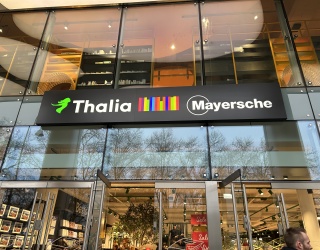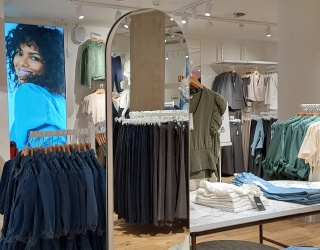
Light creates ambiance. Light triggers emotions. Light influences the purchase decision. The product can have the highest quality, but it requires the correct lighting to completely persuade the customer. In this iXtenso interview, Ralf Knorrenschild, Director of Global Key Account Management at Zumtobel, talks about the current developments and trends in retail lighting.
Mr. Knorrenschild, what factors need to be considered when you plan lighting for a store and individual sales areas?
The most important factors that need to be considered when planning store lighting include energy efficiency, the materials of the product line, the areas where the light is being used, a possible inclusion of natural light as well as a consideration of the lighting outside. The outside ambiance of a store already plays an important role in the pedestrian’s decision to enter the salesroom.
On the one hand, lighting can support the staging and differentiation from the neighboring store, but also create brand recognition besides traditional visual merchandising. Intelligent light planning also increasingly incorporates natural light, especially for larger areas. Shop windows are staged based on outdoor lighting conditions and depending on the time of day optimally controlled and adjusted to the conditions. When it comes to lighting sales areas, we bear in mind that different areas at the POS require different lighting solutions. Spontaneous purchase decisions are often made, because the ambiance, brand presentation and lighting are just right.
How can product lighting influence purchase behavior?
Perception and well-being tremendously influence customer behavior. The staging of brands and products are a key factor for successful business transactions. Eighty percent of information is absorbed just by sight. Light shapes the space, supports the customer with orientation and informs about sizes, surfaces, materials and colors. What’s more, lighting is able to transform the salesroom into an experience and play a leading role in accentuation at the POS. Lighting increases attention and sparks emotions. In doing so, it contributes to the purchase decision considerably.
How important is lighting for the image of a company?
Light is being used to trigger emotions and to create brand identities. Light creates an added value, particularly when lighting concepts and lighting control are viewed and treated as a single unit. Vivid lighting scenarios with various sequences take lighting away from monotony. One major topic in retail is the creation of real experiences, which enable the customer to experience a brand in a sustainable and attractive manner and thereby offer a homogeneous and integrated brand image.
What lighting elements are presently being used in your projects?
Directed light colors, accent lighting or dynamics focus attention and transform shopping into an inspiring experience. Luminance contrast and light distribution are used to make representative products stand out from the crowd. Lighting solutions with several components are generally perceived as more attractive than a general increase in lighting. Today, we are able to realize over 50 percent of our projects with LED lights in retail store lighting.
What trends do you currently see in lighting planning, especially as it relates to the food and non-food sectors?
We see four trends at the moment that are going to increasingly shape our conceptual lighting designs in retail over the next few years. Aside from staging, our lighting solutions combine authenticity, naturalness and sustainability. Contrasts, which are created by varying different color temperatures, light distribution and light quantities play an important part. We offer precise and efficient LED lighting solutions for different lighting tasks as well as architectural settings, which -depending on their use- produce targeted staging and positively affect the ambiance. We noticed that the trend is clearly moving away from diffuse light towards directed lighting. Thanks to a negligible UV percentage, LED lighting solutions enable us to get closer to the product without causing purses for instance to fade.
Zumtobel emphasizes authentic lighting that highlights the character and the quality of the product. People’s health consciousness also manifests on a high level. Naturalness is in great demand as well as quality and comfort. This requires a corresponding lighting concept that reflects this naturalness. Lighting quality with excellent color rendering that is similar to natural daylight persuades the customer. Matching color temperatures brilliantly accentuate the structures and surfaces, which are used in the food area at the deli counter for instance.
Sustainability is currently a hot topic. How can a high level of sustainability be realized in lighting?
Fortunately, we are continuously able to contribute to sustainability with our products and technologies. Aside from labeling particularly sustainable products with the eco+ label, Zumtobel creates environmental product declarations (EPDs) for all its products. The EPDs provide transparency and illustrate all environmental influences for a product over its entire life cycle at a glance. Intelligent controls combined with LED technology demonstrate the most positive effects on energy consumption. Depending on the application, savings amount to up to 70 percent.
Depending on the application area and store architecture, the methods range from daylight sensors to manually dimmable lighting solutions to simple integration of occupancy sensors or timers. The sustainability of the lighting solution starts with planning and ranges from the efficiency of light sources and lamps to lighting management, which integrates natural light as well as occupancy sensors and optimally utilizes natural light. An optimized lighting concept that directs light specifically onto the product and less onto the room makes a valuable contribution. For example, a specially developed LED store optical design that primarily directs light onto the shelf and less onto the aisles is most efficient in a supermarket. The operational lifespan of a Zumtobel LED lighting solution is at least 50,000 hours, which makes lighting replacement unnecessary in everyday retail use, since we are talking about a lifespan of 12-15 years here. What’s more, the low heat output of LEDs protects against undesired rise in temperature and thereby reduces the costs of air conditioning.
Interview: Elisabeth Henning, iXtenso.com






